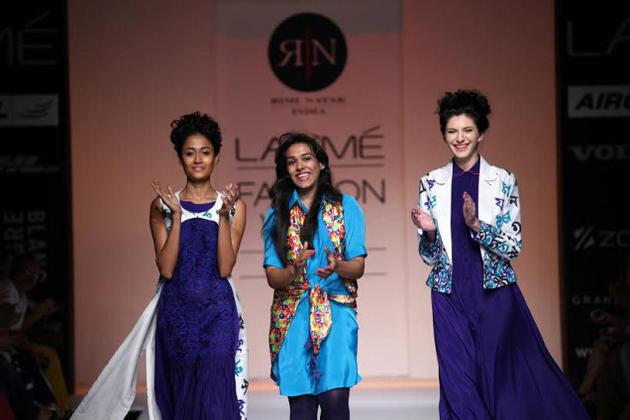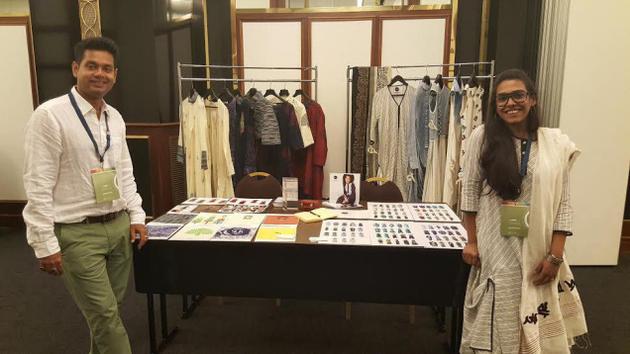
Two Kolkata designers represent the country in Italy
Last month, designers Sayantan Sarkar and Rimi Nayak — both Lakme Fashion Week veterans — were among a group of 18 delegates from various industries who represented India at a four-day trade conference, courtesy the Bengal Chamber of Commerce. The meet was organised in association with the Indian Embassy as a part of the government’s ‘Make in India’ project. Staged across three Italian cities — Milan, San Marino and Rome — the meet was graced by Italian fashion houses, buyers and industry experts, who were duly impressed by Indian craftsmanship, textile heritage and attention to detail.
Saying it in Bengali
Nayak has been working with prints inspired by Bengali fonts since 2013. Her signature Bengali typography prints have earned her rave reviews at the Lakme Fashion Week and celebrity clients such as Vidya Balan, Amrita Rao, Esha Gupta, Sayani Gupta and Yami Gautam. Nayak. The curvaceous look of the Bengali font piqued the curiosity in Italian buyers. “Bengali fonts are visually appealing and have been hugely appreciated in the past.” says the designer.

“I had iconic lines from Tagore’s literature printed on beautiful dresses with my signature drapes. Also, every line in Bengali also had its corresponding English translation. For instance, ‘Pothik tumi ki poth haraiyacho?’ was accompanied by ‘Wayfarer have you lost your way?’ printed beside it.” The ‘world map’ items from her 10-piece capsule collection were also a huge hit with buyers in Milan. “The entire world map was printed on the ensemble in a graphical manner, with names of the countries and oceans written in Bengali and English.”
Nayak, who works extensively with khadi, said that Europeans acknowledged and appreciate the rich heritage of the handloom fabric.
As for the typographical print, she said, “When it comes to typography prints in fashion, you mostly see English, Chinese and Arabic scripts. I am born and brought up in Bengal, although I am Oriya by birth. So I wanted to popularise the Bengali typography as it never got the kind of exposure it deserved.”
Nayak is now expecting potential collaborations through Milan Fashion Week with those who are keen to work with her label. She is looking forward to working on commissions for developing indigenous fabrics for them.
Europeran sensibilities, Indian fabric
Sarkar feels Indian designers ought to harness the craze Europeans have for our fabrics. “You can expect to sell a simple Khadi ensemble for 3000 Euros. That’s the kind of price they are willing to pay.” He has also been approached to develop weaves by ‘mesmerised buyers’ from Italy.
He is amongst the handful of Indian designers who develop their own textiles. He works with craftsmen in the Phulia district of Bengal to create fabrics for his western outfits. “The Chamber of Commerce was seeking someone who would cater to European sensibilities promoting Indian fabric. That’s how they zeroed in on me.”
Sarkar travelled with two collections, featuring trousers, shirts and jackets for women. The former used the khesh technie (a technique which recycles fabric) on the denim. “We have applied it on denim strips, washed them and developed fabric out of them. These fabrics were manufactured in Shantiniketan.” His Mayuraka collection. “had dancing peacock motifs used on shift dresses, tunics and shirts.” The other, more bohemian collection, called Vagabondage, was inspired by “the nomadic gypsy lifestyle” and used the Jamdani weave. The feathers of a dream catcher were used as a recurring motif. It featured shibori with kantha stitchwork and South American Aztec motifs inspired by the traditional Bengali Jamdani textile.
Sarkar concedes that the European market is of the opinion that our silhouettes are not trendy or global yet. “They think we are still very conservative. They demanded a new silhouette range, which we have taken up as our most recent project.” Sarkar is optimistic that his designs will display soon at multi-designer outlets in Rome.
The author is a freelance writer
source: http://www.thehindu.com / The Hindu / Home> News> Cities> Mumbai / by Piali Dasgupta / August 09th, 2016
